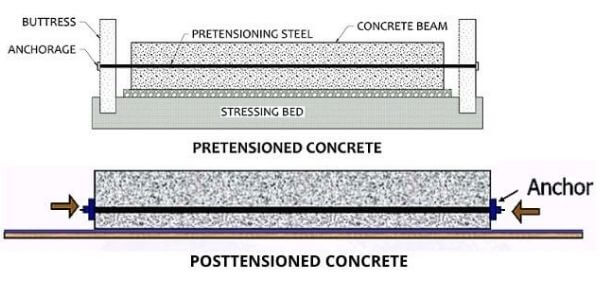Table of Contents
Prestressed Concrete
There are three main types of concrete PCC, RCC and PSC that is Plain cement concrete, Reinforced cement concrete and Pre-stressed concrete, used for the construction of buildings and bridges for a long time.
Concrete is much strong in compression and works well when used as a vertical column whereas when we use it horizontally as a slab or beam concrete can typically span for only short distances.
If we try to increase its length it begins to crack and fail hence, we have to increase its thickness but when we try to use PCC for longer horizontal spans in buildings and bridges its size and weight becomes too large and impractical.
To tackle this problem, we added metal reinforcing bars in the concrete to achieve greater length.
As a result, reinforced cement concrete became an important structural material for bridge construction. Even reinforced concrete has a limited capacity to span distances before cracking and failing under stress.
Hence a new system of concrete is experimented with for creating concrete to increase the span length even further with less weight.
The system is known as pre-stressed concrete. To understand pre stressing look at this concrete member when the load is applied the member bends like this.

you can see here the compression develops at the top portion and tension develops at the bottom portion and due to this elongation at the bottom concrete gets cracks.
To prevent this cracking additional steel bars are added at the bottom section and stretched so that it can resist most of the tension.
The pre-stressed concrete beam is thinner lighter in weight and uses less concrete without cracking or breaking. I have already written a detailed article on prestressing of concrete, you can read it here Prestressed Concrete – Definition, Methods, Advantages and Disadvantages.
Difference Between Pre tensioning and Post tensioning

Prestressing can be done in two ways: Pre tensioning and Post tensioning. In this article, we will discuss the differences between these two methods so let us start.
Concept
In the case of pre-tensioning, the prestressing cables also called strands are tensioned before casting the concrete. Later concrete is cast enclosing the tensioned cables, so in this method, we can say first tensioning and then casting.
Whereas in the case of post tensioning the strands are enclosed within a duct and then concrete is cast. The process of tensioning the strands is carried out after the concrete attains its sufficient strength so in this method we can say first casting and then tensioning.
Where it can be done?
Mostly pre-tensioning is done in factories hence it is suitable for precast construction works.
Whereas post tensioning can be done in factories as well as on-site.
Size limitations
In the case of pre-tensioning, the size of the sections is limited due to transportation restrictions and also due to the availability of cranes capable of lifting the sections into place.
Whereas in the case of post-tensioning the size of the member is not restricted long-span bridges can be constructed with the help of this method.
Members
In case of pre-tensioning similar prestressed members are prepared in a factory if the size variation happens then we have to manufacture a separate mould of that size.
Whereas post-tensioning can be done at the site hence products are changed according to a structure.
Suitability
Pre-tensioning is suitable for small structural elements which are easy to transport.
Whereas post-tensioning is preferred when the structural element is heavy.
Durability
pre-tensioning is more reliable and durable as compared to post-tensioning.
Whereas in the case of post-tensioning the durability depends upon the two anchorage mechanisms.
Loss in pre-stress
while tensioning the cables the cable gets contracted due to several causes which affects the reduction in pre-stress this reduction in prestressing force is called loss in pre-stress.
In the case of pre-tensioning, the loss of prestressing is not less than 18 per cent.
Whereas in the case of post-tensioning the loss of prestressing is not more than fifteen per cent.
Cost
Pre-tensioning is cheaper because the cost of sheathing is not involved in this method.
Whereas post-tensioning is costlier because of the use of sheathing.
Final Words
I hope now you understood the difference between pre tensioning and post tensioning.
If you found this article helpful please share it with your friends.
If you want to add any information related to this article, feel free to mention it in the comment section.
Thanks!
Also, Read
Concrete Mix Ratio – Types, Proportioning of Concrete & Methods
Nominal Mix Concrete Vs Design Mix Concrete
Compaction Factor Test For Concrete Workability
Standard Consistency Test of Cement